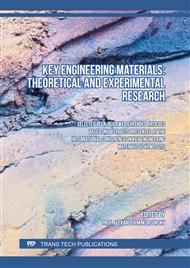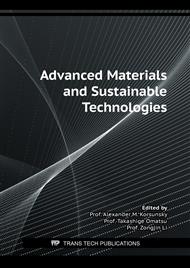[1]
R.G. Jones, J. Kahovec, R. Stepto, E.S. Wilks, M. Hess, T. Kitayama, W.V. Metanomski, IUPAC. Compendium of Polymer Terminology and Nomenclature, IUPAC Recommendations 2008 (the Purple Book,). RSC Publishing, Cambridge, UK, (2008).
DOI: 10.1039/9781847559425-fp009
Google Scholar
[2]
S. Slomkowski, J.V. Alemán, R.G. Gilbert, M. Hess, K. Horie, R.G. Jones, et al., Terminology of polymers and polymerization processes in dispersed systems (IUPAC Recommendations 2011), Pure and Applied Chemistry 83-12 (2011) 2229–2259.
DOI: 10.1351/pac-rec-10-06-03
Google Scholar
[3]
M. Suga, MRI: Quantitative Evaluation of Diseased Tissue by Viscoelastic Imaging Systems. In: Hashizume M. (eds) Multidisciplinary Computational Anatomy. Springer, Singapore, (2022).
DOI: 10.1007/978-981-16-4325-5_39
Google Scholar
[4]
P. Chen, A.M.A.O. Pollet, A. Panfilova, M. Zhou, S. Turco, J.M.J. den Toonder, M. Mischi, Acoustic characterization of tissue-mimicking materials for ultrasound perfusion imaging research, Ultrasound in Medicine & Biology 48-1 (2022) 124-142.
DOI: 10.1016/j.ultrasmedbio.2021.09.004
Google Scholar
[5]
A.V. Khilov, V.A. Shishkova, E.A. Sergeeva, D.A. Kurakina and M.Yu. Kirillin, Agar phantoms of biological tissue for fluorescence monitoring of photodynamic therapy, Kvantovaya Elektronika and IOP Publishing Ltd Quantum Electronics 52-1 (2022) 63.
DOI: 10.1070/qel17967
Google Scholar
[6]
Z.A. Nezhad, G. Geraily, A review study on application of gel dosimeters in low energy radiation dosimetry, Applied Radiation and Isotopes 179 (2022) 110015.
DOI: 10.1016/j.apradiso.2021.110015
Google Scholar
[7]
B. Kent, C. Rossa, Development of a tissue discrimination electrode embedded surgical needle using vibro-tactile feedback derived from electric impedance spectroscopy, Med Biol Eng Comput. 60 (2022) 19–31.
DOI: 10.1007/s11517-021-02454-3
Google Scholar
[8]
M. Rizwan, G.S.L. Peh, H.P. Ang, N.C. Lwin, K. Adnan, J.S. Mehta, W.S. Tan, E.K.F. Yim, Sequentially-crosslinked bioactive hydrogels as nano-patterned substrates with customizable stiffness and degradation for corneal tissue engineering applications, Biomaterials 120 (2017) 139–54.
DOI: 10.1016/j.biomaterials.2016.12.026
Google Scholar
[9]
I. Eunji, N. Hani, H. Masoom, Mechanical stability analysis of carrageenan-based polymer gel for magnetic resonance imaging liver phantom with lesion particles, J Med Imaging (Bellingham) 1-3 (2014) 035502.
DOI: 10.1117/1.jmi.1.3.035502
Google Scholar
[10]
J. Depoorter, C. Dewagter, Y. Dedeene, C. Thomsen, F. Stahlberg, E. Achten, The Proton-Resonance-Frequency-Shift Method Compared with Molecular Diffusion for Quantitative Measurement of Two-Dimensional Time-Dependent Temperature Distribution in a Phantom, Journal of Magnetic Resonance, Series B 103-3 (1994) 234-241.
DOI: 10.1006/jmrb.1994.1035
Google Scholar
[11]
M. Bertasa, A. Dodero, M. Alloisio, S. Vicini, C. Riedo, A. Sansonetti, D. Scalarone, M. Castellano, Agar gel strength: A correlation study between chemical composition and rheological properties, European Polymer Journal 123 (2020) 109442.
DOI: 10.1016/j.eurpolymj.2019.109442
Google Scholar
[12]
J. Jussila, Preparing ballistic gelatine—review and proposal for a standard method, Forensic Science International 141-2,3 (2004) 91–98.
DOI: 10.1016/j.forsciint.2003.11.036
Google Scholar
[13]
R. Wang, Y. Wang, K. Lassiter, Y. Li, B. Hargis, S. Tung, L. Berghman, W. Bottje, Interdigitated array microelectrode based impedance immunosensor for detection of avian influenza virus H5N1, Talanta 79 (2009) 159-64.
DOI: 10.1016/j.talanta.2009.03.017
Google Scholar
[14]
C. Ruan, L. Yang, Y. Li, Immunobiosensor Chips for Detection of Escherichia coli O157:H7 Using Electrochemical Impedance Spectroscopy. Analytical Chemistry 74 (2002) 4814-4820.
DOI: 10.1021/ac025647b
Google Scholar
[15]
T.M.W.J. Bandara, B.-E. Mellander, Evaluation of Mobility, Diffusion Coefficient and Density of Charge Carriers in Ionic Liquids and Novel Electrolytes Based on a New Model for Dielectric Response, Ionic Liquids: Theory, Properties, New Approaches, IntechOpen (2011) 383-406.
DOI: 10.5772/15183
Google Scholar
[16]
A. Hunold, D. Strohmeier, P. Fiedler, J. Haueisen, Head phantoms for electroencephalography and transcranial electric stimulation: a skull material study, Biomedical Engineering / Biomedizinische Technik 63-6 (2018) 683-689.
DOI: 10.1515/bmt-2017-0069
Google Scholar



